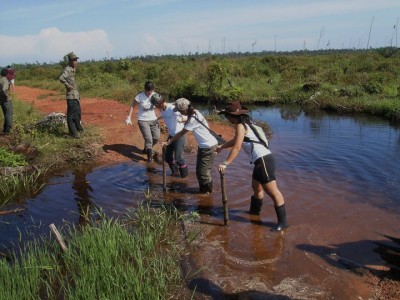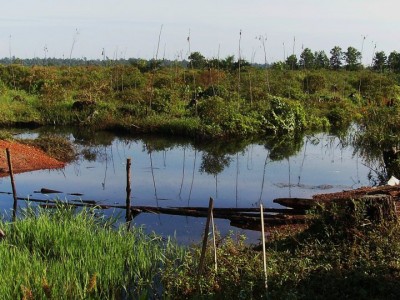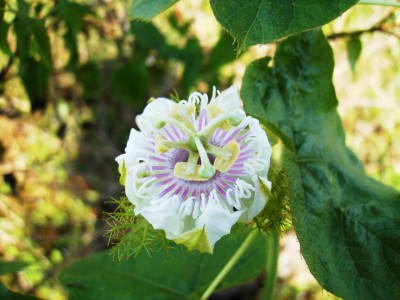
A Malaysian youth reporting on the community based tree planting programme to rehabilitate the Raja Musa Peat Swamp Forest that had fallen victim to some 23,000 hectares of illegal clearing.
Greenk Ink: As you read this, illegal land clearing is once again reported in Raja Musa Peat Forest this week! More on this in our next article.

It has so often been ingrained in us, ours is a country that is loaded with its own resources. One such example is the peat swamp forests found in Malaysia, that in total make up the third largest surface area on the planet. These forests are invaluable assets that mitigate floods, act as critical wildlife habitats, and are among the planet’s most effective carbon stores.
Greedy and apathetic as we are, however, we have up till today allowed 90% of these peat swamps to be cleared, logged or burned in the name of development. The effects of this issue to the environment is alarming, to say the least, but it is the same old story, often told and often heard – so much so that it has to be asked: Is anybody still listening?
One of the dominant issues is the problematic peat fires. Firefighters are tasked with fires that burn violently and almost indefinitely, fueled by its high carbon content. The public’s health is affected by the haze that is spurred on by the flames.
And then there is this: peat swamps lock up carbon, a dirty word in the environmentalist’s book – there’s just too much of it in the atmosphere. When peat swamps go up in flames, the carbon released takes on the form of carbon dioxide, hence contributing further to our already warming climate.
The way in which peat fires occur is fairly straightforward. Peat, formed under very wet conditions, basically consists of semi-decayed vegetation accumulated over time. As long as it is soaked in water, the swamp ecosystem is kept in balance, and all is well. However, when a peat swamp is drained for, say, agricultural, industrial or residential development, the upper layer of the plant material dries up, conveniently forming a combustible and very flammable fuel, which, under excessively dry weather conditions, creates volatile fire hazards.

The Raja Musa Peat Swamp Forest, located in the northern region of the Selangor state, is a part of the North Selangor Peat Swamp Forest. This 23,000 hectare wide peat swamp forest has been victim to illegal clearing and burning to make way for farming activities. Over the years, more than 500 hectares of the forest has been destroyed.
To put that into perspective, that is the equivalent of approximately 600 World Cup size soccer fields.
Thankfully, the Selangor state government has recognised the problem and is currently executing one of the largest forest rehabilitation projects in Malaysia on this location.
The focus is on clearing out illegal settlers and restoring the ruined forest, which creates the core reason why on the occasional Saturday morning, a union of sorts is formed between an unlikely blend of people – corporate workers, salesmen, students and many more. Some may be there to satisfy a curiosity and get the tree-planting experience, but most of them harbor a concern for the condition of the earth, and are acting on it.
One would perhaps find it heartening to know that there ARE still people listening after all.
This tree-planting effort in the Raja Musa Peat Swamp Reserve, planned to take place twice monthly from June till October 2010, is spearheaded by the Selangor State Forestry Department, the Global Environment Centre (GEC), the Sai Council and various other NGOs and community groups such as Eco-Warriors. Before planting, marcots of the Mahang tree species are harvested and then left to soak in the canals in the peat swamps. This is where we volunteers enter the scene.

We arrive as early as 8.oo in the morning and, after a short briefing, start the process of tree planting. The marcots, its newly grown roots still raw and fragile, are placed firmly into the soil, oftentimes while exchanging friendly banter with new friends. The success of restoring a peat swamp forest plays down not only to planting the trees, but also carrying out post planting maintenance such as canal blocking to control the water levels. This is executed in the weeks after the planting of the trees, to ensure that the plants do not die.
So we dig our fingers into the soil and put to work our green thumb. Carrying on until noon, the weather gets pretty harsh – and then we finish up and fill our tummies with the various goodies brought to the table by the organisers. The morning ends with the sun high up, and with our previously soil-stained fingers we sit in the shade and dig into good food with good company, whilst acknowledging that although this isn’t a conventional way to spend your Saturday morning, it is a pretty good one.
LB: The next tree planting dates are 15 August and 28 August 2010. For more info contact GEC.

Hi Lee,
Am in the road industry, mainly into sustainable road, perhaps can contact me at [email protected]?
Thanks
CP
Dear Yap,
I have a research road project on peat in Sibu. Are you interested to assist ? Thanks
Hi, perhaps you can email me so i can get back to you on that? Thanks.
You can reach me at [email protected]
Good day Mr. Yap. This is a very constructive article. I would
like to share some information with you. Please advise your
contact number so that I can call you.
Thank you.
Moorthy
Tree Planting Commettee,
SAI ORGANISATION